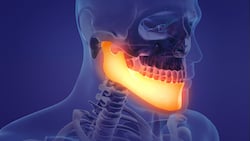 Temporomandibular disorders (TMD) are characterized by pain and functional issues within the stomatognathic system. This intricate network is responsible for vital functions, including chewing, speech, swallowing, yawning, breathing, and facial expression.
Temporomandibular disorders (TMD) are characterized by pain and functional issues within the stomatognathic system. This intricate network is responsible for vital functions, including chewing, speech, swallowing, yawning, breathing, and facial expression.
A recent study by Nicola Marotta, Martina Ferrillo, Andrea Demeco, et al. was published in Applied Sciences, titled “Effects of Radial Extracorporeal Shockwave Therapy in Reducing Pain in Patients with Temporomandibular Disorders: A Pilot Randomized Controlled Trial.” This study examines the synergistic approach of combining physical therapy with or without radial ESWT for adults with myofascial pain and TMD diagnosis. The safety and efficacy of the treatment regimens were explored and assessed.
Conservative Treatments for Temporomandibular Disorders (TMD)
A TMD diagnosis encompasses a range of dysfunctions affecting the muscles, joints, and associated nerves of the jaw leading to often chronic facial pain. Disruptions to the harmonious coordination of the complex jaw function may lead to temporomandibular disorder.
Temporomandibular disorders are characterized as musculoskeletal disorders and are a prevalent condition impacting a significant portion of the population. Over time, many patients with severe TMD or orofacial issues may develop symptoms gradually, and telltale signs include clicking of the jaw and tightness of the jaw, head, or neck muscles. Effective management of the condition aims to alleviate pain, reduce pressure on the jaw joints, restore the jaw’s functionality, and enable normal daily activities.
Conservative therapy approaches for patients affected by TMD may include:
- Oral nonsteroidal anti-inflammatory drugs
- Orthodontics
- Stress reduction, biofeedback
- Electrotherapy
- Physical therapy
- Occlusal splints
- Oxygen-ozone therapy
- Extracorporeal Shockwave Therapy
Shockwave Study Methodology
Study participants included fifteen eligible patients randomly assigned to receive either physical therapy combined with radial ESWT or sham radial ESWT for four weeks. Measurement of pain was assessed using a visual analog scale (VAS). Pain is rated from 0 to 10, with 0 meaning no discomfort up to the highest level of 10, indicative of the worst pain imaginable.
Secondarily, muscle activity and function were evaluated using surface electromyography of the anterior temporalis and masseter muscles.
All patients in the study were over the age of 18 and diagnosed with Temporomandibular Disorders (TMD), and had myofascial pain with or without mouth-opening limitations.
Assessment and Therapeutic Interventions
Once enrolled, all patients were divided following a randomization scheme and even split between the two groups.
Group A (study group) – participants received four physical therapy treatments, 20 minutes duration, along with 3 minutes of radial shockwave therapy, utilizing 2000 pulses, 1.8 bars of energy density flux, and 18 Hz frequency once per week over a 4-week period.
Group B (control group) – participants received the same treatment as above but with sham radial shockwave therapy.
All participants received a 4-week rehabilitative treatment protocol which is considered semi-standardized.
Clinical Outcomes and Conclusions of the Synergistic Approach
The rESWT group combined with physical therapy showed a statistically significant reduction in pain intensity compared to the sham rESWT group with physical therapy. The synergistic approach combining shockwave with physical therapy showed dramatically improved muscle activity and performance, as evidenced by the percentage of overlapping coefficient (POC). Throughout the study, no dropouts or side effects were recorded.
In conclusion, this pilot randomized controlled trial (RCT) suggests that combining radial ESWT with physical therapy is efficacious in alleviating pain and enhancing function in patients with TMD. Further, the study findings highlight this synergistic treatment modality's potential benefits and warrant expanded exploration in larger-scale studies.
To further explore the potentials of combining shockwave with manual therapies, be sure to watch the webinar: The Benefits of Combining Shockwave and Manual Therapy.
Harness the Power of Regenerative Technologies to Accelerate Healing
Incorporating regenerative technologies into your practice can unlock multiple benefits for patients and practice alike. These innovative technologies, such as Extracorporeal Shockwave Therapy (ESWT) and Electromagnetic Transduction Therapy (EMTT), can revolutionize patient care, particularly for patients sidelined by musculoskeletal disorders and pain. Repositioning your practice as a leading provider of regenerative therapies sets you apart from nearby competitors and attracts a new stream of potential patients. Doing so also fosters loyalty and exponential growth potential.
Benefits for Your Patients:
The successful integration of ESWT and EMTT into your treatment protocol offers game-changing patient advantages—the ability to deliver faster and more effective outcomes. Doing so allows patients to reap the rewards of improved recovery timelines and quicker return to activities they love most. By expanding non-invasive treatment options, you will improve patient experience and satisfaction.
Benefits for Your Practice:
Offering advanced therapies, including ESWT, EPAT, and EMTT, positions you at the forefront of patient care and excellence. You’ll naturally attract new patients seeking innovative regenerative treatment options. This distinction develops your practice reputation and cultivates a loyal and expanding patient base, up-leveling ROI.
Learn More and Connect:
Interested in exploring the impact of ESWT, EPAT, EMTT, and other regenerative solutions from CuraMedix? Our team of experts is ready to address your inquiries and offer guidance. Discover how these innovative technologies can elevate your practice and improve patient outcomes. Contact us today to learn more about the possibilities that lie ahead.



